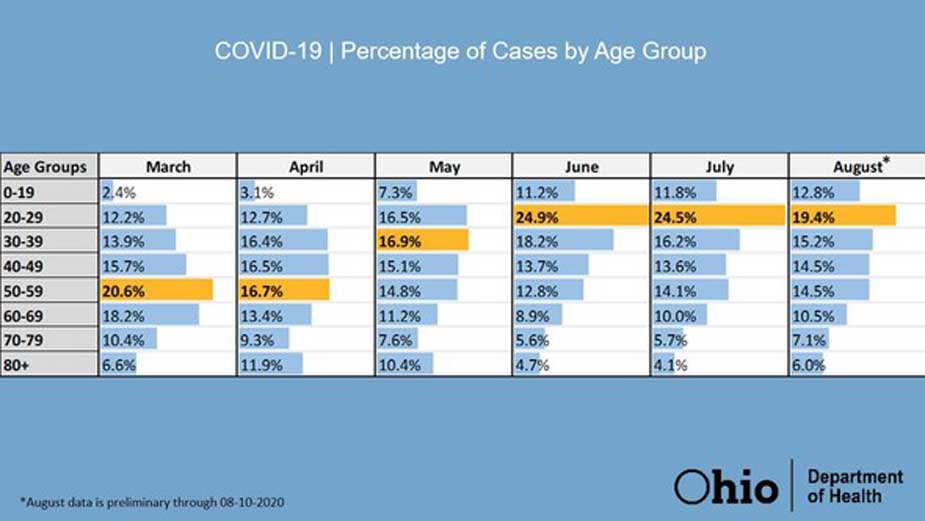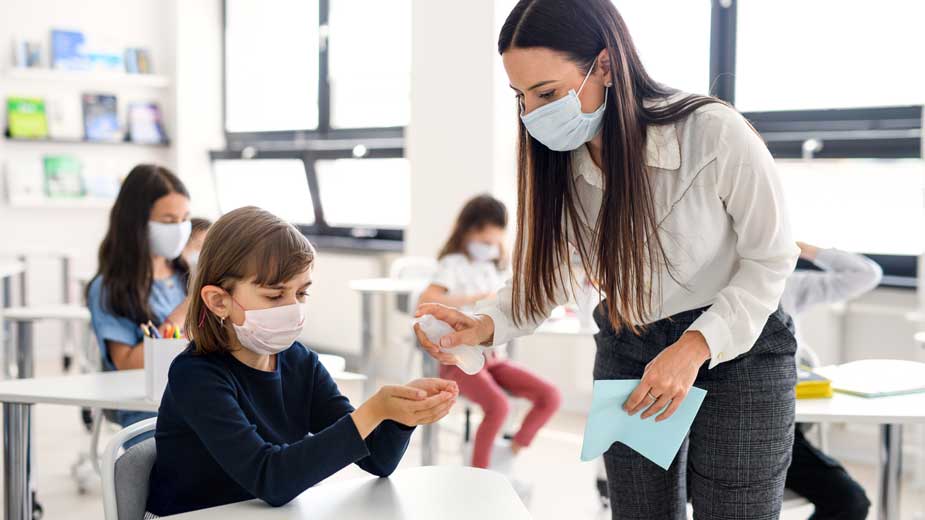DeWine, Doctors Offer Back-to-School Guidance
YOUNGSTOWN, Ohio – Gov. Mike DeWine emphasized Tuesday that the success of return-to-school efforts is going to greatly depend on what happens outside the classroom as well.
At his coronavirus briefing, DeWine was joined by leaders at three Ohio children’s hospitals to address issues of concern as schools across Ohio prepare to resume classes in the coming weeks.
According to DeWine, 325 public school districts plan to start with full-time in-person instruction, representing 590,000 students, or roughly 38% of public school students in the state. Another 55 districts with 398,000 students, or 25.6% of students, will start with fully remote instruction. Another 154 districts with about 380,00 students, or 24.5% of students, will do some form of hybrid schooling.
The state didn’t have data on another 78 districts. The data did not include information on parochial schools or other options.
While the governor has “every confidence” that teachers, administrators and staff are doing all that they can to create a safe environment for students, whatever is going on in the community will be reflected in schools, he warned.
If parents, grandparents and the general public want students to be able to go to in-person schools, play sports or participate in other activities, “Then it’s incumbent on all of us, every single one of us, to do everything we can to keep down the spread in the community in which that school is,” he said.
Young people typically are seen as being less vulnerable to the virus and suffer less sever effects, but are not immune to it. That point and others were emphasized by DeWine and the three physicians who joined him: Dr. John Barnard, chief of pediatrics at Nationwide Children’s Hospital, Columbus; Dr. Patty Manning, chief of staff at Cincinnati Children’s Hospital in Cincinnati; and Dr. Adam Mezoff, chief medical officer at Dayton Children’s Hospital in Dayton.
In March, young people up to age 19 represented just 2.4% of total cases. In August, that has risen to 12.8%, according to state data. Ages 20 to 29 now account for 24.5% of total cases, up from 12.2% in March.
“Children get coronavirus infection. They get it not infrequently,” Barnard said. About 90% fare “exceedingly well” but a little less than 10% do not, and with certain medical conditions it can become critical.
According to testing done at Ohio’s children’s hospitals, of 14,000 who reported COVID-19 symptoms over the past five months, 8.6% tested positive, he said. Out of 20,000 asymptomatic youth who were tested because they were being admitted for other illnesses or because they were going to have surgery, the positive rate has risen from 1.4% in mid-March to 2.9%.
Older teenagers or young adults – 17 or older – are showing the highest prevalence of positivity, likely because they are more mobile and more socially active, Barnard said.

The medical community is still learning what children can do in terms of spreading the disease, but they aren’t immune to it, and when they get it they can spread it, Manning said. “It’s safe to say if a child has COVID they can be contagious, whether they have symptoms or not,” she said.
The medical community is biased toward in-person education if possible, she said. Safely doing so requires four strategies she outlined in descending order of importance:
Masks. “Everyone who can wear a mask should wear a mask,” she stressed.
Distancing. While six feet of distance is optimal, it won’t always be achievable, she acknowledged. “Some distance is better than no distance,” she said.
Hand hygiene, such as washing hands and using hand sanitizer.
Cleaning surfaces. “The good news is COVID is not very hardy. It dies when it dries and it dies in the sunlight,” Manning said.
Additionally, areas that are better ventilated show lower rates of disease transmission, so any time that a teacher can open a window or take a class outside will help as well.
“Together they create a very robust package for safety,” she advised.
One piece of advice she said she has shared with parents is to let children know that it is OK to be uncertain. “We’ve been dealing with a tremendous amount of uncertainty and sometimes children look to use for recognition and approval of that uncertainty,” she said.
Manning echoed DeWine’s earlier comments about how what his done in the community will impact school, and vice versa.
“If we want children to do these things, if we want children to wear masks, we have to wear masks. We have to model that behavior for them as the adults and the parents in their lives,” she stressed.
Mezoff shared samples of protocols that are being developed to outline what actions schools need to take based on various scenarios. Major factors include whether someone has been within six feet of a child who tests positive for COVID-19 for 15 minutes or longer, or “significant exposure” as defined by the Centers for Disease Control and Prevention.
“As school starts up, there will be a lot of questions, a lot of concerns and a lot of things that may change,” he said. The challenge often comes symptoms that aren’t as clear.
Among the scenarios he offered was a student who rode the bus every day for a 10-minute ride to school and tested positive on the weekend. Assuming the student sat at the back of the bus, the bus driver wouldn’t need to be isolated. Additionally, the driver, students who sat near the infected student on the bus or teachers and students in class would not need to be tested unless they showed symptoms.
“We know that testing can be a challenge so we’re trying to be good stewards of that resource,” he said.
In another scenario involving a student volleyball player who tests positive, the student’s coach and teammates would need to isolate at home and get tested if they develop symptoms.
“Not all the illnesses we see this fall are COVID, but having said that, one of the messages we’ve given to our hospital staff, and I would give to the schools, is if you’re sick, stay home,” he said.
Guidance on fall sports is expected soon, but those decisions “aren’t made in a vacuum,” DeWine said. Earlier in the day, the Big Ten Conference announced it would cancel the fall college football season.
Part of the argument for sports is the discipline associated with it, DeWine said. “Part of that discipline this year will have to be discipline than the normal discipline. Part of the discipline this year will have to be being safe,” he said.
It’s also important what student athletes do when they’re not in school or practice, the governor continued. Coaches and teachers have “a great opportunity” to help them understand that the choices they make outside school may determine whether or not they’re going to be able to play, he said.
In addition, DeWine said he was considering asking school districts to provide information on infections. “It enables parents to make decisions,” he said.
DeWine said he is optimistic that Congress and President Donald Trump would eventually reach an agreement on a new coronavirus aid package and that Trump was right to issue his executive order over the weekend to provide a federal boost to the benefit paid to those now on unemployment.
A $300 per week additional payment is being discussed with the administration, down from the $600 provided before the benefit expired at the end of July.
“As far as Ohio adding to that we don’t have the ability to do that,” the governor said. Money would have to be taken from someplace else to do that.
DeWine began the news conference with a rundown of the numbers. There have been 102,826 recorded cases of COVID-19 in the state.
“The good news is we’re seeing a little downturn in the number of cases, 1,095 in the last 24 hours,” DeWine said. Deaths to date total 3,708, including 35 deaths in the last 24 hours.
The governor also reported that Columbiana County has the ninth highest occurrence rate. Over the past two weeks, Columbiana has reported 111.9 cases per 100,000 people, or 114 cases.
There were outbreaks at two long-term care facilities, and there are concerns about “large venue events such as flea markets” where few people were seen wearing face coverings or observing social distancing.
Flea markets, which generally are held outdoors, are “a lot of fun,” but DeWine reminded their operators to do everything they can to promote social distancing and encouraged people to wear masks when they are there.
Copyright 2024 The Business Journal, Youngstown, Ohio.



